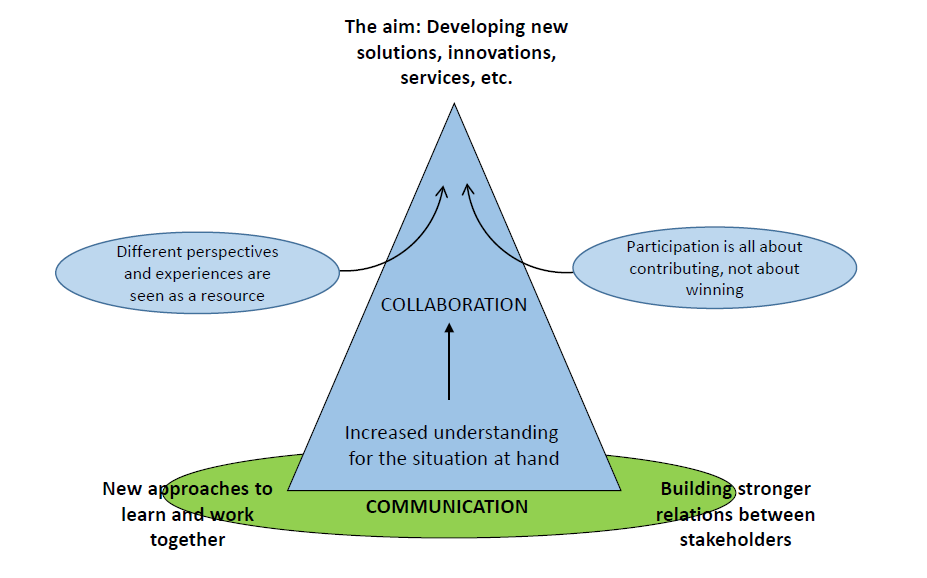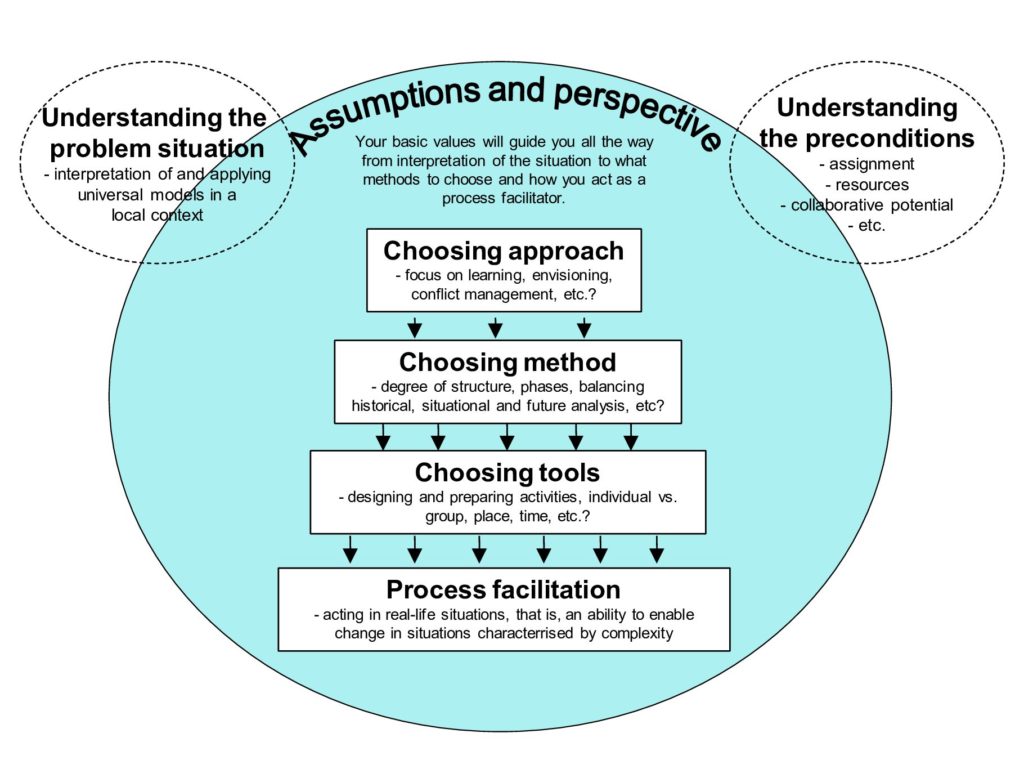The progress triangle
The complexity of many water and land management situations is related to the multiple issues, stakes, goals and parties at hand, as well as the difficulties of predicting the consequences of measures taken in socio-ecological systems. Such complexity suggest that progress is only possible if we continuously learn from our experiences made. Three factors can be used to represent the different domains in which progress can occur; relationships, procedures, and substance, what has been labelled “the progress triangle” (Daniels and Walker, 2001). Collaborative water and land management decisions and multi-stakeholder partnerships must consider all these domains.
This progress triangle also reminds us that substantive progress depend on how good we are at implementing innovative methods, tools and procedures, as well as strengthen the relationship among involved parties (figure 4). Substance represent the issues (often both practical and scientific) that are to be managed or reached. Procedure and methods represent how we chose to work together, from overall process design to specific tools to reinforce learning. Relationship represent the importance of trust, power equality and constructive dialogue among people involved.

It is important to remember that innovative water management on landscape level always includes the whole triangle. It also means that different perspectives and experiences are a resource for learning and that participation is about contributing, not winning. If stakeholders hold such attitudes the potentials for sustained improvements are higher. Furthermore, the three domains overlap and effect one another. By applying new methods and tools we support learning and therefore the outcomes (substance), and if we focus on building trust we create better preconditions for future collaboration (stronger relationship). Consequently, the progress triangle illustrates how substantial improvements in complex issues are dependent on the procedures used, and the relationships built between the participants. Without a process that tries to manage the true complexity, and without strong relationships between the involved participants, the potential for tangible and sustained improvements of the situation will be very small.
In collaborative processes the procedural aspects are put to the fore. Of course, collaborative learning and decision making is about creating substantial improvements in problematic situations. Collaboration is not static, but constantly evolving and adapting to new circumstances. The progress triangle by Daniels and Walker (2001) summarises the core elements of collaboration, putting the earlier mentioned guiding principles and values in a universal model.
Communicative competence
Communicative competence can be defined as following three dimensions (these dimensions are valid for all participants):
- Adaptability, which means that competent communicators assess situations and when necessary adapt their expectations and behaviours accordingly.
- Appropriateness, which means employing communication behaviours that are appropriate to the specific situation, as judged by the participants and yourself.
- Effectiveness, i.e., means that competent communication behaviours are effective in achieving the shared communication goals.
The leaders, be it administrative or collaborative leaders, becomes communicative role models. This is of course even more so for the process facilitator. They have a responsibility to “walk the talk”. But in order for multi-stakeholder processes to develop and to be successful (in substance, procedure, and relational) all participants have to have some basic communicative competence. Each participant have to be able to adapt to the other participants perspectives, employ behaviour and speech seen as appropriate, and be effective in achieving their own communicative objectives. If done successfully, the participants will also value those criteria and try to communicate with the same ambitions and skills. To reach a communicative rationality of such a kind, emotional and ethical dimensions of interaction have to be appreciated. The participants have to recognise each other as subjects, care for and esteem each other.
Pedagogical competence – knowing when to do what and why
Pedagogical competence can be described as the ability and the will to apply such guiding principles, values, tools and skills that promote learning and development among the participants. This shall take place in accordance with the objectives of the collaborative efforts and within existing framework and preconditions. It presupposes continuous development of the leader’s own competence. In short, it is the skill to transform good ideas into concrete and relevant learning activities.
Lack of pedagogical competence is often reflected in an overuse of traditional educational, top-down approaches to issues characterised as complex and controversial. As said earlier, different perspectives is a fundamental resource for learning and innovation. A trained pedagogue (leader/facilitator) has the skills to build on these experiences in a group, but pedagogical competence is more than that. It is also about knowing when to do what. That is, timing.
Depending on where the participants are in the collaborative process (progression), the leader must take decisions on what to do next. Sometimes one need to make a temporary halt in the work, and return to earlier issues. Sometimes a window of opportunity emerge, functioning as a leverage point for the group, perhaps leading to a bypass from the planned process. And sometimes you just follow the jointly agreed process design. What it really means is that you as responsible (leader/facilitator) need to be fully aware about achievements made, changing external and internal preconditions, and the participants’ reactions to what happens.
Making strategic decisions in process design
Now it should be clear that if you as a leader are supposed to suggest a process design for the forthcoming work, there are many dimensions to take into consideration and strategic decisions to be made. First, you need to have a basic understanding of the problem situation at hand, as well as the formal preconditions for the process. Secondly, it is important to be aware of you own assumptions, guiding principles and values which will guide your work (strategically to practically). Finally, there is a lot of decisions to be made about overall approach, methods, tools and the actual facilitation (in real life settings). Figure 5 put these dimensions together in one model.

If the collaborative leader is responsible for suggesting an overall process design, the process facilitator will enact the ideas and visions when standing in front of people, practicing participatory work. That is why there has to be a close cooperation between leaders and facilitators throughout the process.